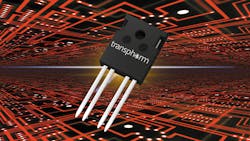GaN to Bring Bidirectional Current and Voltage Control
Power semiconductor upstart Transphorm said it has landed a contract with the U.S. Energy Department’s Advanced Research Projects Agency-Energy (ARPA-E) to build a better bidirectional switch out of gallium nitride (GaN).
The company plans to develop a four-quadrant switch that supports bidirectional current and voltage control. The GaN-based switch promises to open the door to a host of new power-converter technologies that are impractical with regular silicon due to limitations related to cost, heat, weight, area, and efficiency.
The switch will use two gates to block voltages with “+” or “–” polarity and pass current in both directions. As a fully integrated chip, it opens the door to improvements in power density, reliability, and system cost.
The new contract is part of the CIRCUITS program, which hopes to fund innovations in power converters that could give the U.S. the technological edge in areas such as electric vehicles (EVs) and renewable energy.
ARPA-E, modeled on the U.S. Defense Department’s Defense Advanced Research Projects Agency (DARPA), is allocating up to $30 million for CIRCUITS, though the funding for Transphorm was not announced.
Shaking Up Silicon
GaN is shaking up the silicon-dominated area of power electronics. Everyone, from nascent firms such as Transphorm and Navitas to industry leaders Infineon and Texas Instruments, is pushing the envelope with new generations of power ICs that promise to make GaN more accessible. Consumer electronics giants are swapping out even more of the power components in fast chargers for GaN-based ICs.
GaN has a host of unique physical properties, including improvements in on-resistance (RDS(on)), that allow it to switch significantly faster than standard silicon. As a result, more power can be packed into electronics ranging from fast chargers to solar inverters to power converters in EVs. This opens the door to smaller form factors that weigh less and dissipate far less heat, improving power density and cutting charge times.
The high-speed switching of GaN shrinks the transformers, capacitors, and other passive components that round out a power system. That results in significant space and cost savings on the PCB.
GaN-based ICs are also ideal as power converters, offering power efficiency gains when converting ac to dc. Furthermore, power electronics based on GaN can handle higher breakdown voltages.
But GaN’s power-saving properties are not the only reason why many companies, even Apple, favor the advanced semiconductor. They are betting that the unique characteristics of GaN, plus improvements made by the likes of Transphorm, will create new possibilities for power-converter applications.
A new breed of microinverters that can be attached to solar or other renewable infrastructure is not out of the question with the bidirectional switch in development at Transphorm. Instead of converting power for several solar panels, as standard inverters do, a microinverter gets paired with a single solar panel. That gives it the ability to manage the dc-ac power conversion to the electric grid more efficiently, according to ARPA-E.
In addition, Transphorm’s bidirectional GaN switches have the potential to make solid-state circuit breakers more viable by making them significantly smaller and far more energy-efficient.
The new switch could also be used in the “cyclo-converters” at the heart of integrated motor drives (IMDs), which combine the motor and power converters driving it, into a single high-power-density system. Today, these all-in-one systems are very expensive and unable to scale effectively to higher power levels.
A Voltage and Current Crossroads
Transphorm’s standard lateral GaN FETs can inherently provide bidirectional current flow. But a wide range of power-conversion topologies will also need two-way voltage control to effectively manage power flow.
How this currently works is by placing a pair of FETs in series and using the devices’ body diode to steer and control current flow, or by using two IGBTs and two diodes—as many as four parts in total, said the company.
In contrast, a true bidirectional switch like Transphorm’s integrates all of these building blocks in a single chip that supports bidirectional voltage and current-flow control. The integration helps keep noise in check, too.
The company pins the high level of integration in the new switch on the lateral architecture of GaN. It can squeeze the switch on a compact die because the voltage blocking region of the device is shared. This configuration is impractical—or impossible—with vertical power ICs, such as silicon or silicon carbide (SiC), said Transphorm. SiC is another relatively new class of power semiconductor suited for very high voltages.
Transphorm plans to prototype the four-quadrant switch using its 650-V GaN technology with a high threshold voltage of 4 V in a 4-pin TO-247 package. It plans to complete the contract in less than a year.
About the Author
James Morra
Senior Editor
James Morra is the senior editor for Electronic Design, covering the semiconductor industry and new technology trends, with a focus on power electronics and power management. He also reports on the business behind electrical engineering, including the electronics supply chain. He joined Electronic Design in 2015 and is based in Chicago, Illinois.

